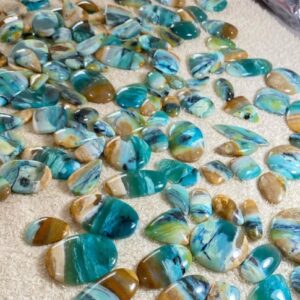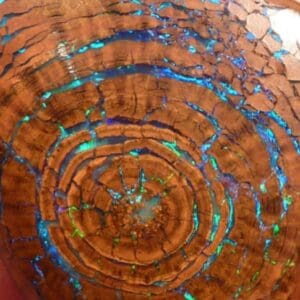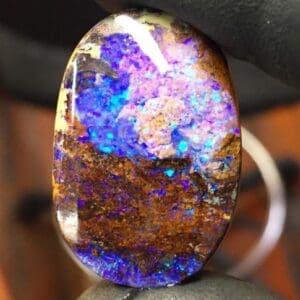Opalized Petrified Wood is also known as Wood Opal or simply Opalized Wood. It’s actually a form of Petrified Wood that’s developed an opalescent sheen, or more rarely, where the wood is entirely replaced by Opal. Often, Opalized Petrified Wood is used as a gemstone.

Is Opalized Petrified Wood Valuable?
While some folks hear the word “opalized” wood and automatically think it’s more valuable than other types of Petrified Wood. This would be true if the Opal is “Precious Opal,” exhibiting a fine play-of-color. Wood petrified by precious Opal exists, and fine specimens will sell for extremely high prices.
That said, most Opalized Wood is common Opal. If you don’t know what common Opal looks like then take a look at the image above. You’ll notice the cabochons have solid colors with no play-of-color.
As with most gemstones, pattern, color, and beauty are usually what determines Opalized Wood’s value. If you have a gorgeous specimen of Opalized Wood made into a pendant, pin, or other jewelry item it could be sold for a higher price.
Stunning specimens of wood petrified by Precious Opal can fetch incredibly high prices. This is because they have the beauty of Precious Opal combined with the fact that it’s an organic gem.

What Is Opalized Petrified Wood?
Opalized wood is Petrified Wood composed of Opal instead of Chalcedony or another mineral. This form of Petrified Wood almost always consists of common Opal and lacks the play-of-color that Precious Opal has. But there are rare instances where Petrified Wood is composed of precious Opal.
Before we dig into Opalized Wood, let’s briefly discuss how Petrified Wood is made.
As the internal structure of a plant breaks down, it replaces the organic material or wood fibers with silica and other minerals. These minerals crystallize over a few million years, resulting in a rock that takes over the original tree’s structure and shape.
The petrification process occurs underground when the wood becomes buried in water and saturated by sediment or volcanic ash. The presence of water naturally reduces the availability of oxygen, which inhibits natural aerobic decomposition. Mineral-laden water that flows through the sediments can lead to permineralization, which happens when minerals precipitate and fill the interiors of cells and other empty spaces.
There must be a balance between the decaying cellulose, lignin, and mineral templating for the cellular detail to be preserved well. Most of the organic matter usually decomposes.
Silica, in the form of Opal-A, can permeate and encrust wood quickly in hot spring environments. However, Petrified Wood is commonly associated with trees buried in fine-grained sediments, floodplains, ash beds, and volcanic lahars.
Okay, back to Opalized Wood.
A series of Rhyolitic volcanic flows resulted in a large basin enclosed by low hills. The basin contained a succession of lakes and forests of hemlock, spruce, chestnut, birch, and sequoia trees, which were periodically buried by volcanic ash that was hundreds of feet thick. A large lake formed in the basin depositing large amounts of a biogenic form of Silica called Diatomite. Seepage of super-heated water percolated through those layers of ash that carried the silica to the buried trees.
Replacing carbon in the wood with hydrated Silica caused perfect Opalized replicas of the original wood structures. The alignment of hydrated Silica spheres ultimately caused the rainbow effect of Precious Opal. It was the result of the deflection and diffraction of light that passes through the planes of hydrated silica molecules. The size of the silica spheres impacts the colors, with smaller spheres resulting in blues, while larger spheres contain shades of red.
While common Opal is abundant in the occurring areas, the conditions required for forming Opalized Wood is a combination of a stable and undisrupted environment.
Simply put, Opalized Wood is a form of Petrified Wood that has developed an opalized sheen.

How Can You Tell If Petrified Wood Is Opalized?
Silicified wood composed of Opal can be easily identified from those composed of Chalcedony by three physical properties. In many instances, the less-common Opalized Wood isn’t recognized because more people automatically assume it’s Chalcedony, and no testing is done.
Opal has a lower specific gravity, a lower hardness score, and a lower refractive index. Any of these identification factors can be used to separate Opalized wood from Chalcedony.
Opalized wood can be as equally as beautiful as Petrified Wood that’s composed of Chalcedony. However, Opalized wood has durability differences. It’s less suitable for wearable jewelry and lapidary projects. Because Opalized wood has a lesser hardness, it’s damaged more easily by abrasion. It also has a lower tenacity and is likelier to break by exposure to stress or upon impact.

How Long Does It Take For Petrified Wood To Opalize?
There is no way to determine the exact amount of time necessary for wood to petrify or become opalized. The time frame generally ranges from hundreds of thousands to millions of years.
- Identify Enstatite - March 12, 2024
- Identify Cerussite - March 3, 2024
- Identify Bytownite - February 18, 2024

One Response
How utterly amazing this is. I hadn’t realized that it has to be a combination of different things to have this beautiful gemstone to be created. Such beauty once again created by nature and the perfect combination of various things required. Thank you for your sharing of the information